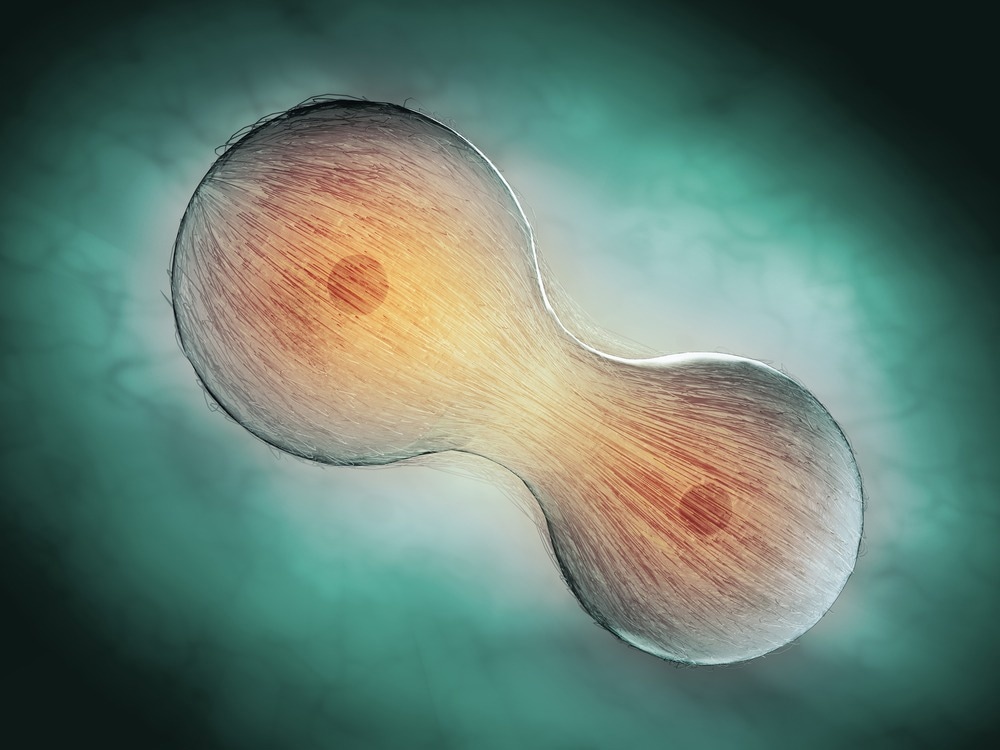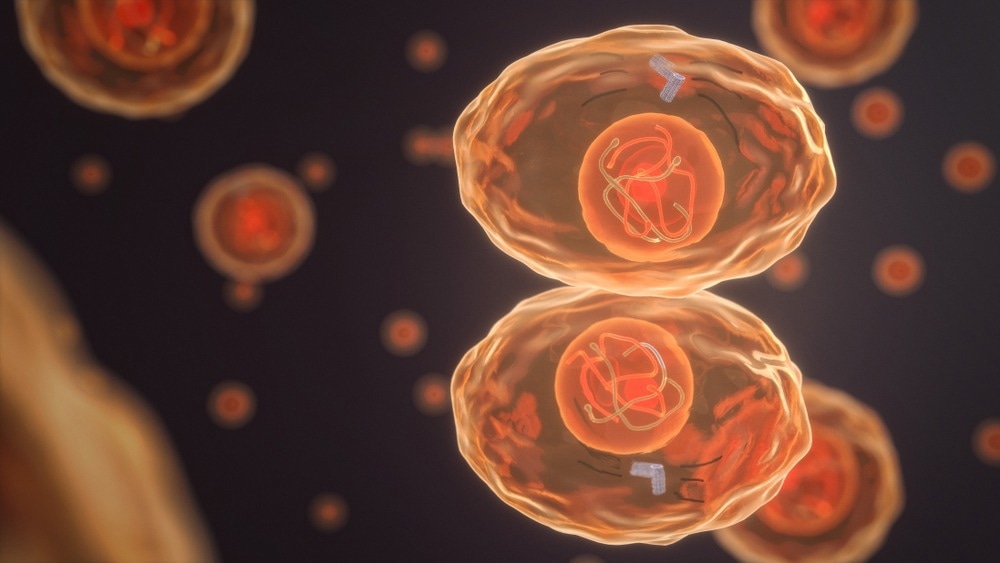Cellular division is crucial to the life cycle of cells - ensuring growth, repair, and reproduction. Involving a series of stages, cell division contains specific events and checks to maintain the integrity of genetic material - that being deoxyribose nucleic acid, famously abbreviated as DNA. When abnormalities occur, there are profound consequences that can contribute to diseases such as cancer.

Image Credit: Mopic/Shutterstock.com
1. Interphase
The cell division begins here at interphase, a phase comprising three sub-stages: G1 (cell growth), S (DNA synthesis), and G2 (preparation for division).
G1 Phase (Gap 1)
The G1 phase is the first stage of interphase, preceding DNA synthesis. During G1, the cell undergoes significant growth, accumulating nutrients and energy required for the upcoming phases (S and G2). The G1 phase is crucial for preparing the cell for DNA replication and subsequent division.
Cells that are not actively dividing may enter a resting state called G0, which involves a temporary or permanently ceased cell cycle. The G1 checkpoint is a crucial regulatory point as the cell assesses whether or not to proceed with DNA synthesis. If conditions are favorable and the cell is deemed fit for division, it progresses to the S phase.
S Phase (Synthesis)
Following G1, the cell enters the S phase, where DNA synthesis or replication occurs. Within this phase, the cell duplicates its genetic material to ensure that each resulting daughter cell receives a complete set of chromosomes. Thus, the S phase is known to be highly orchestrated, involving the unwinding of the DNA double helix, the synthesis of new complementary strands, and the verification of accuracy.
The successful completion of the S phase is crucial for maintaining genetic integrity. A range of regulatory proteins and checkpoints monitors this phase, ensuring that DNA replication proceeds accurately and any errors are promptly corrected. Once the S phase is completed, the cell proceeds to G2, continuing its preparation for cell division during the subsequent phases of the cell cycle.
G2 Phase (Gap 2)
The G2 phase marks the final preparations before entering mitosis, and is characterized by continued cell growth, with a focus on the synthesis of proteins and the accumulation of necessary resources. A checkpoint also ensures the accuracy of DNA replication, checking for errors and damages, thus monitoring overall integrity, whereby in the detection of DNA damage, the cell cycle may arrest for repair.
Simultaneously, cellular organelles, such as mitochondria, duplicate, ensuring that each daughter cell will have a complete set during division. As G2 is a phase of preparation for mitosis, the cell synthesizes microtubules and other components essential for cell division.
The activation of Cyclin-Dependent Kinases (CDKs) in G2 triggers the transition to mitosis, entering the mitotic phase and leading to the formation of two genetically identical daughter cells.
Interphase Abnormal Consequences
Abnormalities occurring during interphase exert profound effects across a spectrum of diseases. One notable consequence is the initiation and progression of cancer, as errors in DNA replication and disruptions in cell cycle regulation contribute to uncontrolled cell division and genomic instability.
Neurological disorders such as Alzheimer's and Parkinson's diseases may involve disruptions in cell cycle regulation and DNA replication within neural cells. Metabolic disorders, congenital anomalies, premature aging syndromes such as Hutchinson-Gilford progeria, and autoimmune diseases such as rheumatoid arthritis also have links to interphase irregularities.

Image Credit: Anusorn Nakdee/Shutterstock.com
2. Mitosis:
Mitosis, an important stage in the cell cycle, involves the precise division of the cell nucleus, culminating in the creation of two genetically identical daughter nuclei. The stages are as follows:
Prophase
During prophase, chromosomes undergo condensation via large protein complexes called condensin and transform into structures visible under a microscope. Spindle fibers also emerge from centrosomes, extending between opposite poles of the cell and acting as the molecular scaffold. Simultaneously, the nuclear envelope dissolves, which is a pivotal event that sets the stage for chromosomal movement - where, at this stage, it may also be known as prometaphase.
Metaphase
Metaphase is when the alignment of chromosomes along the cell's equatorial plane, known as the metaphase plate, takes place. The spindle fibers, now fully formed, delicately attach to the centromeres of each chromosome, preparing for the subsequent separation. Checkpoints at this stage focus on whether the spindle fibers are securely assembled, and only successful assembly will allow cells to enter Anaphase.
Anaphase
In Anaphase, the dynamic separation of sister chromatids occurs, migrating towards opposite poles of the cell. The contracting spindle fibers play a crucial role, mediating the precise movement of genetic material and ensuring an equitable distribution between the emerging daughter cells.
Telophase
Telophase serves as the finale of mitosis, wherein chromatids reach their respective poles. As the genetic material settles into distinct regions, new nuclear envelopes form around each set, and thus forming two discernible nuclei.
Mitosis Abnormal Consequences
Arising from errors in chromosome segregation during mitosis, Aneuploidy results, which is characterized by abnormal chromosome numbers, and when occurring in meiosis (sex cells version of cell division), it is often associated with genetic disorders such as Down syndrome.
The link between mitotic abnormalities and cancer is pronounced, as tumor cells are known to have aneuploidy in association with abnormalities in mitotic checkpoint proteins. Furthermore, cells experiencing severe mitotic errors may undergo programmed cell death (apoptosis), while those evading apoptosis can perpetuate genetic abnormalities. Additionally, mitotic abnormalities during embryonic development can lead to developmental defects, and prolonged mitotic stress may induce cellular senescence, contributing to aging and age-related diseases.

Image Credit: nikdesignt/Shutterstock.com
3. Cytokinesis
Following mitosis, the cell proceeds to cytokinesis, that is, the division of the cytoplasm and organelles. In animal cells, this process manifests as a cleavage furrow, a contracting ring that pinches the cell's midsection and partitions it into two separate entities.
In plant cells, it is slightly different, whereby a unique mechanism unfolds as a cell plate emerges - gradually extending across the cell's middle - and eventually transforms into a new cell wall, consequently creating two distinct daughter cells.
Cytokinesis ensures the completion of the cell division process, giving rise to two independent and genetically identical daughter cells.
Cell cycle phases | Cells | MCAT | Khan Academy
Video Credit: khanacademymedicine/YouTube.com
Cytokinesis Abnormal Consequences
Failures in cytokinesis may result in cellular polyploidy, whereby a single cell possesses multiple nuclei or leads to binucleation, affecting normal cellular functionality. Such aberrations contribute to chromosomal instability, potentially fueling cancer development. Incomplete separation of chromosomes during cytokinesis may also give rise to micronuclei, which are often deliberately induced in cell-based assays, known as cytokinesis-block micronucleus (CBMN) assay, for research purposes.
Sources:
10.2A: Interphase [Internet]. Biology LibreTexts. 2018.
Levine MS, Holland AJ. The impact of mitotic errors on cell proliferation and tumorigenesis. Genes & Development. 2018 May 1;32(9-10):620–38.
Dechat T, Shimi T, Adam SA, Rusinol AE, Andres DA, Spielmann HP, et al. Alterations in mitosis and cell cycle progression caused by a mutant lamin A known to accelerate human aging. Proceedings of the National Academy of Sciences [Internet]. 2007 Mar 14;104(12):4955–60. Available from: https://www.ncbi.nlm.nih.gov/pmc/articles/PMC1829246/?report=reader
Kiener H, Ackermann J, Redlich K, Radda I, Steiner C, Bitzan P, et al. Interphase fluorescence in situ hybridization analysis of fibroblast-like synoviocytes of patients with rheumatoid arthritis and osteoarthritis. Arthritis Research & Therapy. 2001 Feb 9;3(S2).
Joseph C, Mangani AS, Gupta V, Chitranshi N, Shen T, Dheer Y, et al. Cell Cycle Deficits in Neurodegenerative Disorders: Uncovering Molecular Mechanisms to Drive Innovative Therapeutic Development. Aging and Disease [Internet]. 2020 Jul 23;11(4):946–66. Available from: https://www.ncbi.nlm.nih.gov/pmc/articles/PMC7390532/
O’Connor C. Cell Division: Stages of Mitosis | Learn Science at Scitable [Internet]. Nature.com. 2008. Available from: www.nature.com/scitable/topicpage/mitosis-and-cell-division-205/
Dominguez-Brauer C, Thu Kelsie L, Mason Jacqueline M, Blaser H, Bray Mark R, Mak Tak W. Targeting Mitosis in Cancer: Emerging Strategies. Molecular Cell. 2015 Nov;60(4):524–36.
Vraneković J, Božović IB, Grubić Z, Wagner J, Pavlinić D, Dahoun S, et al. Down Syndrome: Parental Origin, Recombination, and Maternal Age. Genetic Testing and Molecular Biomarkers [Internet]. 2012 Jan;16(1):70–3. Available from: https://www.ncbi.nlm.nih.gov/pmc/articles/PMC3265771/
Kops GJPL, Weaver BAA, Cleveland DW. On the road to cancer: aneuploidy and the mitotic checkpoint. Nature Reviews Cancer. 2005 Oct;5(10):773–85.
Ohshima S. Abnormal mitosis in hypertetraploid cells causes aberrant nuclear morphology in association with H2O2-induced premature senescence. Cytometry Part A. 2008 Sep;73A(9):808–15.
Vakifahmetoglu H, Olsson M, Zhivotovsky B. Death through a tragedy: mitotic catastrophe. Cell Death & Differentiation. 2008 Apr 11;15(7):1153–62.
Pucci B, Kasten M, Giordano A. Cell Cycle and Apoptosis. Neoplasia (New York, NY) [Internet]. 2000 Jul 1;2(4):291–9. Available from: https://www.ncbi.nlm.nih.gov/pmc/articles/PMC1550296/
Lacroix B, Maddox AS. Cytokinesis, ploidy and aneuploidy. The Journal of Pathology. 2011 Nov 14;226(2):338–51.
Hayashi MT, Karlseder J. DNA damage associated with mitosis and cytokinesis failure. Oncogene [Internet]. 2013 Jan 14;32(39):4593–601. Available from: https://www.ncbi.nlm.nih.gov/pmc/articles/PMC3681845/
Fenech M. Cytokinesis-block micronucleus cytome assay. Nature Protocols. 2007 May;2(5):1084–104.
Further Reading
Last Updated: Nov 20, 2024